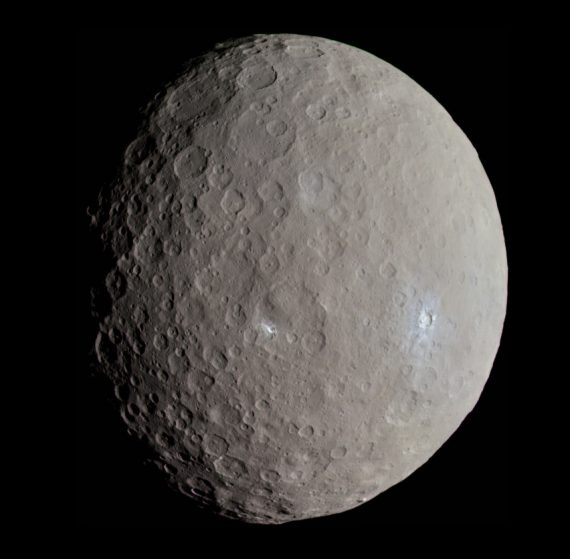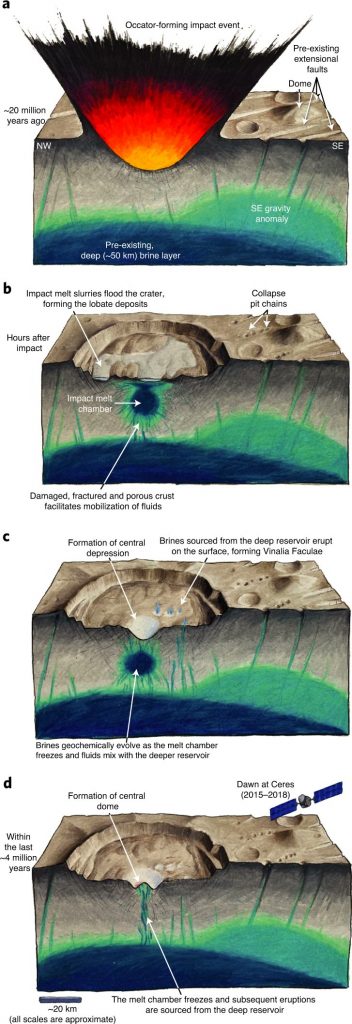Media
Transcript
After our regular news coverage, we’ll be joined by Dr. David Grinspoon. Last week, David attended a Technoclimes workshop where a select group of researchers from around the world came together to try and define what we need to understand so we can go searching for other civilizations orbiting other stars. While we’ve long known looking for radio signals was a possibility, today we’re finding a myriad of other technological possibilities, and we’re going to learn what the possibilities are together right after the news.
Today’s space headlines are all shouting a single name: Ceres. Originally thought to be a planet, this largest of all asteroids was visited by the Dawn spacecraft from 2015 to 2017. Even before Dawn entered orbit, we knew this world wasn’t going to be as simple as we expected; bright and confusing spots were seen on the surface. Over the years, myriad papers have tried to explain this complex object, and this week the journal Nature Astronomy has dedicated an entire issue to trying to explain this world.

We couldn’t fully read the issue prior to going live today, so we’re only going to hit some highlights for now. On Thursday, we will have Georgia Tech post-doc and Dawn team member Ky Hughson join us to discuss the results in greater detail. For now, this is what you need to know.
Ceres is classified as an asteroid for the very simple reason that it is in the asteroid belt. This 588-mile across object is about one-fifth the size of Mercury, is in hydrostatic equilibrium (which is a fancy way of saying gravity settled it into a nice round shape), and it has complex geology that includes some tectonics that is driven by subsurface brines – think super salty water instead of magma. The continued presence of this liquid can be determined from gravity data collected by Dawn, and it appears this briny reservoir is 25 miles deep and hundreds of miles wide.
That shiny spot that has captivated so much attention lies in the heart of Occator Crater. Roughly twenty million years ago, something – most likely a smaller asteroid – struck Ceres and dug down through its surface toward the brine beneath.
During impacts, all the kinetic energy from the impactor’s motion gets released as heat, shockwaves, and other forms of energy that can together melt the impact site which will later cool from the surface inwards. In the case of Ceres, this formed a cap over a now-weakened region, and the salty fluid erupted out through various parts of the 57-mile-across crater floor, forming Vinalia Faculae. These erupting ice volcanoes are called cryovolcanoes.

Over time, the subsurface melt also froze, and in combination with eruptions of fluid from deeper below, led to the formation of Occator Crater’s central dome. Those erupting brines left sodium carbonate – a compound of sodium, carbon, and oxygen – on Ceres’ surface.
Let me put that a different way: liquids got to the surface of Ceres two different ways. According to Dawn mission principal investigator Carol Raymond: For the large deposit at Cerealia Facula, the bulk of the salts were supplied from a slushy area just beneath the surface that was melted by the heat of the impact that formed the crater about 20 million years ago. The impact heat subsided after a few million years; however, the impact also created large fractures that could reach the deep, long-lived reservoir, allowing brine to continue percolating to the surface.
There are amazing illustrations of this process that were created by James Tuttle Keane. He regularly posts illustrations of science news on Twitter as @jtuttlekeane.
One of the most exciting parts of this research to me is the evidence that these eruptions may be ongoing, with some features appearing to be less than two million years old and containing materials that can only survive on the surface for hundreds of years.
According to the JPL press release: On Ceres’ surface, salts bearing water quickly dehydrate, within hundreds of years. But Dawn’s measurements show they still have water, so the fluids must have reached the surface very recently. This is evidence both for the presence of liquid below the region of Occator Crater and ongoing transfer of material from the deep interior to the surface.
While Dawn wasn’t lucky enough to catch any active eruptions, future missions will be better off. I’m really hoping.
Learn More
Dawn XM2 at Occator crater
- USRA press release
- Max Planck Institute for Solar System Research press release
- NASA JPL press release
- Planetary Science Institute press release
- “Recent Cryovolcanic Activity at Occator Crater on Ceres,” A. Nathues et al. 2020 August 10, Nature Astronomy.
- “Impact-driven Mobilization of Deep Crustal Brines on Dwarf Planet Ceres,” C. A. Raymond et al. 2020 August 10, Nature Astronomy.
- “Evidence of Non-uniform Crust of Ceres from Dawn’s High-resolution Gravity Data,” R. S. Park et al., 2020 August 10, Nature Astronomy.
- “Fresh Emplacement of Hydrated Sodium Chloride on Ceres from Ascending Salty Fluids,” M. C. De Sanctis et al., 2020 August 10, Nature Astronomy.
- “Impact Heat Driven Volatile Redistribution at Occator Crater on Ceres as a Comparative Planetary Process,” P. Schenk et al., 2020 August 10, Nature Communications.
- “The Varied Sources of Faculae-forming Brines in Ceres’ Occator crater Emplaced via Hydrothermal Brine Effusion,” J. E. C. Scully et al., 2020 August 10, Nature Communications.
- “Post-impact Cryo-hydrologic Formation of Small Mounds and Hills in Ceres’s Occator Crater,” B. E. Schmidt et al., 2020 August 10, Nature Geoscience.
Credits
Written by Pamela Gay
Hosted by Pamela Gay
Audio and Video Editing by Ally Pelphrey
Content Editing by Beth Johnson
Intro and Outro music by Kevin MacLeod, https://incompetech.com/music/


 We record most shows live, on Twitch. Follow us today to get alerts when we go live.
We record most shows live, on Twitch. Follow us today to get alerts when we go live.